Kelty Yukon 48
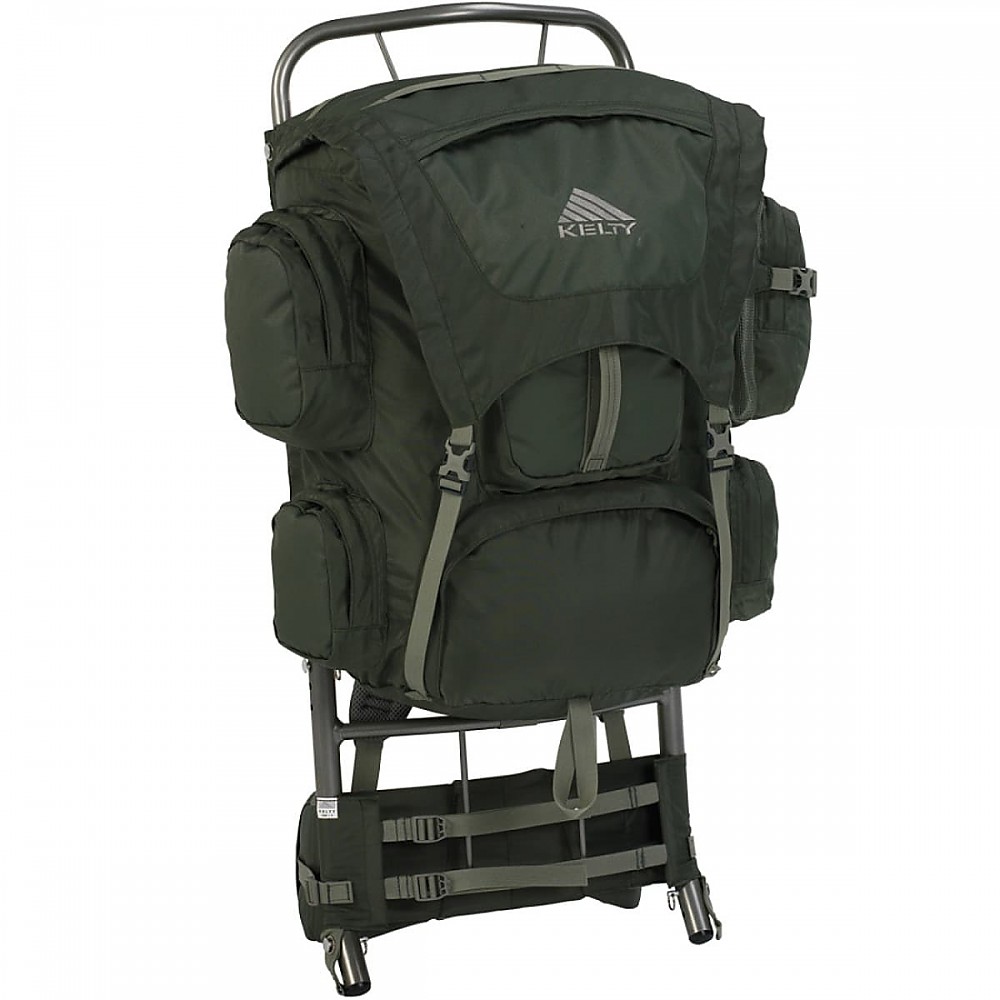
Yukon 48 is my fugged-about-it pack. It might not do everything well. However, you can trust the pack to do just about everything. It's the multi-tool of the backpack world.
Pros
- Simple
- Versatile
- Affordable
- Durable
Cons
- "Features" are sometimes extraneous and/or poorly designed.
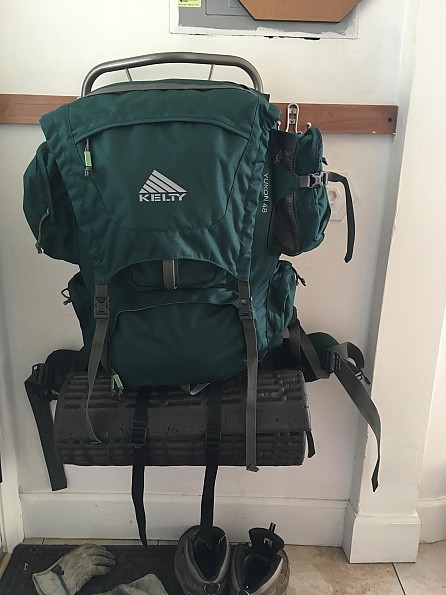
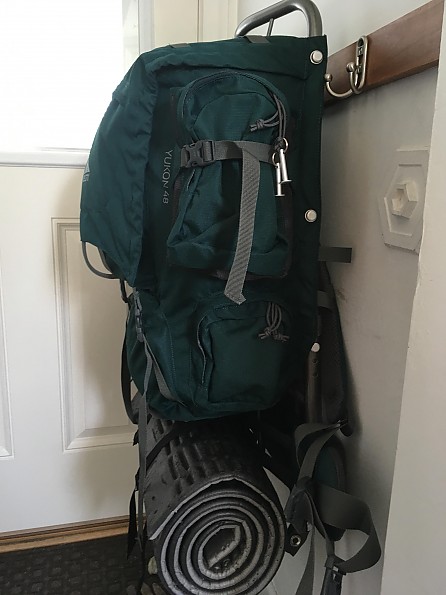
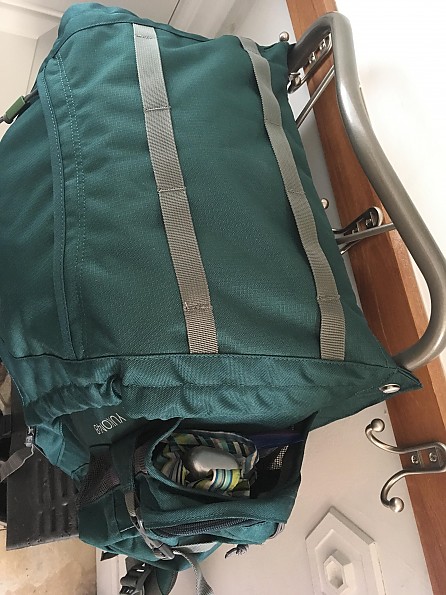
Construction:
There's nothing particular unique or exciting about the Kelty frame pack. Humans have been using external frames for thousands of years. For instance, most people will notice Native American cradleboards are essentially small, baby-laden external frames. You have a rigid frame with a bundle attached to it. The materials have changed but the form remains the same. The Yukon 48 is no exception.
Ride:
The frame itself will support basically anything you attach to it. Unlike internal frame packs, weight is not strictly speaking a limitation. The lighter weight internal frames will "crush-out" on you when placed under too much load. The upper limit is usually about 60 lbs even for really beefy internals. However, most designs realistically only carry about 30-40 lbs comfortably. Not that anyone wants to carry 60 lbs all day. However, weight is one less thing you need to worry about when using an external.
Organization/Ease of Use:
This is the true advantage of a Kelty over other packs. There's less to think about. I can go from a lightweight summer camping trip to a bulky winter trip with very minimal alteration. The same change with an internal frame might take a few days tinkering and toying before I figure out the "right" way to pack everything. More realistically, I can swap out different gear for different occasions with minimal fuss. Perhaps I want to bring my luxurious camping mat and a 12-pack of PBR for that one night trip with friends. No problem. The Yukon top compartment is suspiciously well-designed for carrying PBR.
Capacity/Comfort:
Conversely, the pack isn't going to get in the way of a minimalist trip either. All my gear fits in the main compartments. I use my clothes and shelter to fill the dead space. I'd be doing this in an internal frame anyway. Next you'll say but what about the weight? If I'm looking at the spreadsheet, yes, the external is about 2 lbs heavier than my internal counterpart. Most people don't have a quiver of packs though and an external is always more comfortable than a poorly loaded internal.
Since the subject came up in comments, I'll mention a word on international travel.
Compression:
Contrary to popular opinion, external frames do have certain advantages while traveling. The first thing everyone complains about is air travel. True, you're never going to fit an external frame in an overhead bin. However, you need to assume your internal frame won't fit either. There is a decent chance the airline will force you to check a bag somewhere along your journey when you'd really rather not.
As a result, I found myself carrying a cheap nylon duffel to the airport no matter which bag I was taking. (The airline conveyor belts will tear any bag to shreds.) The external frame was actually easier because I knew ahead of time I would use it. Everything was pre-packed in a way that made disassembly and reassembly easy. Worst comes to worst, the external isn't going to punish me for chucking a disorganized mess in the bottom.
Feature:
The other thing most people don't think about when traveling is conspicuity. Your $300 shiny new internal frame is more likely to walk off than the $50 Kelty your parents bought you for scouting. I would leave mine unattended at the front of the pub and no one ever touched it. My friend's jacket got stolen off the coat rack right next to it but no one messed with my pack. Likewise, I could leave my external in the backseat with open windows, no problem. With the internal frame, you'd come back to a broken window. Thieves seem to have an aversion to external frame packs for some reason.
More Compression:
I'll give the internal one solid advantage. They are easier to fit in a station locker. I normally leave the pack at whatever room/hostel I'm staying at and carry a collapsible day pack. Essentially a reusable shopping bag with shoulder straps. This strategy runs into problems on transit days. Of course... your travel bag should only weigh about 20 or 25 lbs anyway. Your gear should mostly be floating in the sack. If you 86 the bottom compartment and pack everything flat against the frame, the two top straps do a decent job of keeping the pack flat. If you really care, you can repurpose cinch straps for compression but I never bothered. In really tight spaces, I just take the pack off and hold it in front of me. It only weighs 20 lbs.
Warning:
Carry a few zip ties with you. If you blow one of the cotter pins, the bag will detach from the frame. Without a spare, you're in for a headache. You can rig something with paracord but I've found zip ties are far and away the easiest field repair. Enjoy.
PS: I added pictures per request. I don't have an action shot handy. Apologies.
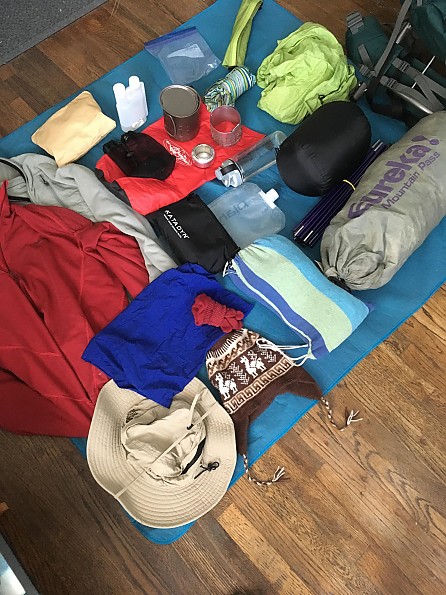
This is a pretty standard 3-season kit. Not super light. Not super heavy. Average. I spoofed a little. I'm using a 1.5 kg hammock instead of a food bag. I don't feel like raiding the pantry. So what's in the bag...
From Left:
Mid-weight insulating layer; fleece; bandanna; glove liners; sunhat; warm hat; 10 essentials (headlamp, first aid, ect.); fuel bottle, dry bag/bear bag; 0.5 L cook pot; alcohol stove; windscreen/stand; 2 L Platy; water filter; 1 L water bottle; "food" bag; extra zip locks/dry bag; rain gear (umbrella/windbreaker); 30° down sleeping bag; tent poles; 2-person tent; Therm-a-Rest; pack.
As you'll notice, the Therm-a-Rest is the only thing packed on the frame. I don't need 3 of the 6 zipper pouches either. There's space left even with the ones I used. I can obviously adjust this setup quite a bit. For one thing, I wouldn't normally carry a 2-person tent for just myself. I prefer a hammock most days. Alternatively, if I'm carrying the tent, someone else is carrying the food bag. I'd probably use the added space for a book and some camp sandals. Maybe some spirits or a PBR or two.
For winter, I'd simply move some bulky items on top, add an extra sleeping pad and warmer clothes. I'd swap out the stove for a Whisperlite or something similar. Probably ditch the water filter and carry extra fuel for melting snow. Chlorine tabs as a backup. Drop the rain gear. Add some traction. You get the point...
Background
Kelty Yukon was my first and primary pack for about 15 years. I've used it everywhere outside the zombie apocalypse. The original was given away when I relocated across country. The 2nd edition is now hanging in my gear room and still sees regular use.
Source: received it as a personal gift
This is the pack that I always return to. Easy to pack and to carry. Durable and adaptable. Excellent for smaller adults.
Pros
- Easy and forgiving to pack
- Comfortable (cool and adjustable)
- Readily available used
Cons
- Organization slightly inflexible
This review pertains to the older version of this pack, which has somewhat less heavily padded and shaped hip belt and shoulder straps, no sternum strap, no provision for a water bladder, and lashing tabs on the top flap and back pocket, rather than a daisy-chain.
Conditions: I have used this pack for eight years, for several trips annually of one to seven days.
Construction and Durability: Shows no serious signs of wear, except for scratches on the frame.
Fit and Comfort: This pack is usually listed as a "youth" pack, but it would be a big kid. It fits me, a full-grown 5'8" 150 lbs woman, very well. The width of the frame is still a bit much for my 14-year-old son.
The placement of the shoulder straps can be adjusted for broader or narrower shoulders, the hip-belt for height, and the height of the frame is adjustable. It is an external frame pack, and hence not so sweaty on the back.
Capacity and Compression: The best thing about external frame packs is that you can get pretty much anything into or onto them. For the thrifty or just-starting-out who are using older and less-than-premium gear, it's just not going to fit into an internal frame pack. This also matters if (when camping with children, for example) you carry more than your own share of the gear.
What some perceive as a downside is that some things will probably be "onto" rather than "into." The upside is that the capacity is very flexible. In addition to "onto" vs. "into" the top flap cinches down quite tight effectively compressing smaller inside loads, but has plenty of room for larger ones. I removed the "hold-open" bar (it connects to the pins that hold the bag to the frame) for more flexibility.
Organization and Accessibility: Some organization is forced by "onto" vs. "into." The main pocket is partially divided; it is open down the sides to slide in long, narrow things (e.g. tent poles); the upper portion is reached through the top, the lower through a zip-open panel. It's not always quite right for what needs to go in.
Similarly the side pockets are often too small or too large. One upper side pocket is open-topped, to put a water bottle in. Said bottle is not really accessible when the pack is on, and not much good for anything else. On this pocket there is a zippered flap pocket, which is pretty much useless when a bottle is in the pocket.
NEVERTHELESS, with a more modern-style internal frame pack, I find I often have to repack the whole thing if I take anything out, and I much prefer this.
Ease of Use: Adjustments to the frame height and placement of straps and belt require moving pins, but it's obvious how to do it.
Ride: Like an external frame pack, for good and ill. Sometimes has to be man-handled rather than worn in tight or awkward spots (subway turnstiles, narrow crevices). But carries heavy loads easily, and with minimally fussy packing.
Source: bought it used
Price Paid: $30 used
Best for: Taking plenty of heavy gear (for whatever reason) long distances into the backcountry. The pack carries the load quite well and comfortably. It will also stand up to real use and bushwhacking with no durability issues.
Recommended: Very much yes.
For whom: Folks who want/need to take heavy gear without being concerned with "babysitting" their pack. It can take a beating and will not let you down.
Pros
- Durable
- Carries heavy loads comfortably
- Allows your back to breathe (external frame)
- Belt buckles are forward-pull
Cons
- Heavy pack
- Hydration sleeve is horizontal (only fits two liters)
- No load lifters (Kelty Trekker has them)
I own this pack and the Kelty Trekker (larger but external frame pack as well).
This pack fits both my fiance and I with adjustment. Our heights differ by almost a foot, so this pack has plenty of size adjustment. Shoulder, hip and sternum straps/belts have plenty of room to fit most any adult.
As for comfort, it's quite comfortable with even very heavy loads (think medium format camera gear, tripods and all that plus normal backcountry gear, food, water, etc.). Once dialed in, there's no pressure points being hit and the pack distributes weight in such a way that you know the weight is there, but can't point out any one place where it's coming from.
The hip belt and shoulder straps are padded well with no "digging in" or pinching and such. Being an external pack, it breathes well with only some webbing touching your back and allows a nice breeze between you and the pack.
The capacity is fine. I can't speak to exact liters for "true to advertised" judgement, but it will fit medium format camera gear and backcountry setups without problem.
Access to contents is great due to the nature of being an external pack — pockets everywhere and plenty of lashing points. Use a hydration bladder though, you cannot get to any pockets while wearing the pack and there aren't any hip belt pockets.
As for compression and volume adjustments, there is a hold-out bar one can use to really "open up" the pack if things get bulky. Aiding in this is the pack lid that can either be cinched down all the way or allowed to ride higher with more contents in the main body - so very adjustable by way of volume handled.
Easy to use? Yep, just fill it up (properly), strap any sleeping pads (or other bulky but light gear) on the top or bottom and go. The sleeping bag compartment zippers can be a little fiddly due to the ample flap over the zipper track, but one really only needs to use those zippers maybe twice a day.
Features I like:
- forward pull belt straps (very easy to use)
- very robust body material that will take a beating
- sturdy (adjustable) frame
- very nice load carrying ability
Construction level, as I've noted, is heavy duty. You're not going to damage this pack by setting it down. In fact, I'm not sure how one would damage this pack without doing rather serious personal injury in the process at all.
This pack has seen several seasons of backcountry use — on trail and off trail. Wet and dry conditions; dirt and rocks and bushwhacking and less-than-gentle use. It's been used for photographic day trips and heavier photographic backpacking trips, both in East Coast forest areas (humid, hot and plenty of very dense forest).
Buy a pack cover or use a pack liner, this pack is not waterproof. It will shed a short light shower, but if rain is really coming down, you need to use something to keep your gear dry.
Source: bought it new
Price Paid: I do not recall
1. The pack is adjustable for comfort, putting the weight mostly on the belt and off the shoulders and back.
2. The convenience of the pockets is great.
3. The extra weight is offset by the overall comfort and back ventilation.
4. Water is easy to transport either in camel back pouch, side pockets, or top of pack.
5. For lite carriers, I've had no problem going less then 20 lbs. and hiking comfortably.
Update: September 20, 2009
I hiked the first 500 or so miles of the Appalachian Trail five years ago with this pack. I loved its comfort after a lady hiker showed me how to adjust the frame so that the weight was on the belt and not the shoulders (that occurred two days out of Damascus, Va.).
I loved the convenience of the pockets, the way that the sweat wasn't on the backpack but rather the back stays fairly cool and comfortable, the durability is excellent, the color is woodsy, the compatibility with water storage.
I've tried "lighter backpacks" and have found that the ultra factor is not comfortable or convenient. I'm sticking with the best - Kelty.
Design: external frame top load sack
Size: 2900 ci
Number of Pockets: 7 pockets
Max. Load Carried: have carried 50 lbs. but prefer 17 lbs.
Height of Owner: 5 ft 10in
Price Paid: $65
Great, durable backpack, used from Cub Scouts to present (I'm 30).
Pros
- Durable
- Airy
- Comfortable for long hauls
Cons
- Heavier than ideal
- Water bottle pocket is hard to reach on the trail
I've had this pack since I was 12, and save for a couple squirrel holes internally (my bad. [cub scout]), it's held up amazingly.
I've recently gotten into lightening my load (considerably), and took a seam ripper to it (it's from 1997, and I couldn't stand getting rid of it) to fit my new lightweight approach. It now sits just over 3 lbs, and functions as an extremely comfortable (and rugged...(can't do the Cuben/sil-nylon, as I do a lot of bushwacking) lightweight pack.
I'll use it until it dies. :)
Source: bought it new
Price Paid: ?
Your Review
Where to Buy
You May Like
Specs
| Price |
MSRP: $179.95 Historic Range: $50.00-$179.95 Reviewers Paid: $30.00-$89.00 |
| Weight |
5 lbs 1 oz / 2.3 kg |
| Volume |
2900 cu in / 48 L |
| Torso Fit |
13 - 19 in / 33 - 48 cm |
| Dimensions |
22.5 x 23 x 11 in / 57 x 58 x 28 cm |



